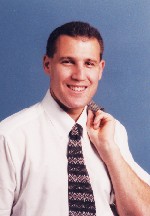Diagnostic Data Your Diagnosis 1. Scheiman M, Wick B. High AC/A Conditions: Convergence Excess and Divergence Excess. In: Scheiman M, Wick B. Clinical Management of Binocular Vision: 2nd ed. Philadelphia: Lippincott Williams & Wilkins; 2002:3-120; 264-304.

A 13-year-old girl presented for an eye exam with a chief complaint of blurry vision at distance. She also stated that at least twice a week she saw double when reading with her glasses on, which made it more and more difficult to stay on the honor roll at school. She denied any allergies or using medicines, and everything else in her history was noncontributory.
Her entering visual acuity through her habitual correction of -0.25D sphere O.D. and -0.50D sphere O.S. was 20/50 O.D. and 20/60 O.S. at distance, with 20/20 equivalent at near in each eye. Cover testing through her glasses revealed orthophoria at distance and 2 prism diopters (PD) of esophoria at near. Versions were full and smooth. The near point of convergence was to the nose. There was no evidence of afferent pupillary defect. Color and stereo testing were normal. Refraction uncovered -1.25 O.D. and -1.75 O.S. with acuities measured at 20/20.
Base-in vergences were 4/6/0, and base-out vergences were 25/35/25. The AC/A ratio was 7/1. Her anterior segment and dilated fundus findings were normal in both eyes.
How would you approach this case? Does this patient require additional tests? What is your diagnosis? How would you manage this patient? What is the likely prognosis?
Discussion
The diagnosis in this case is convergence excess. Additional tests could have included accommodative amplitude testing (13.00D O.U.), monocular estimation method (MEM) retinoscopy (+1.00 O.U. through subjective, binocular and monocular accommodative flippers (BAF: 0 cpm, fails minus, MAF: 10 cpm), vergence facility (0 cpm, fails BI), and negative and positive relative accommodation (NRA/PRA) (+2.50/-1.25). With an AC/A of 7 to 1 and vergences measuring 4/6/0, the patient would only accept -0.75 before appreciating blur or diplopia.
Management for this patient consisted of a pair of bifocal glasses. The additional plus at near relaxed her accommodative convergence and decreased her base-in demand, allowing her eyes to maintain an exo posture.1-3 In a classroom setting, a bifocal format is most effective for looking back and forth between the chalk board and desk work. The amount of plus prescribed can be calculated based on the accommodative convergence to accommodation ratio (AC/A).1,2 This patient had 2.00 PD of esophoria at near with -0.25D sphere O.D. and -0.50D sphere O.S. Cover testing with -1.25D sphere O.D. and -1.75D sphere O.S. showed 9 PD of esophoria, which corroborated the measurement of her AC/A at 7/1. In order to achieve the optimal posture of between 0-6 prism diopters of exophoria, the patient"s MEM and base-in findings were normalized along with the NRA/PRA by prescribing a bifocal spectacle containing the appropriate distance prescription along with a +1.50 add.1,2 A second option would be to offer the patient the choice of removing her spectacles for extended near tasks.
Captain Melissa A. Carr, O.D., U.S. Army, contributed to this case. Dr. Carr"s opinions are her own and do not represent those of the Army.
2. Taub MB. Binocular vision anomalies: What every optometrist should know. Optometry Today 2004 Jun;4:42-45.
3. von Noorden GK, Binocular Vision and Ocular Motility. 3rd ed. St. Louis: Mosby;1985:420-21.

